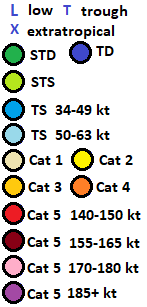Verification of tracks made on TD 11 using GEFS mean fields
I made five tracks about Tropical Depression Eleven. Additionally, within 384
hours of cyclogenesis, there were 15 instances, when I missed
cyclogenesis entirely. Brevity was somewhat well predicted, but both formation and dissipation times were generally too early. TD 11 ended up becoming nameable storm in most of the tracks, often a hurricane.
As of this analysis, best track positions are available September 18, 00Z thru September 23, 12Z, and as such, position comparisons are possible only for this timespan.
Since I give only SSHS categories in my tracks, I don't calculate intensity errors in units of speed, but in categories. For this purpose, I define tropical or subtropical storms as "Category 0", tropical or subtropical depressions as "Category -1" and non-existence of a tropical or subtropical cyclone as "Category -2".
In the five tracks, formation times ranged between September 16, 00Z and September 19, 12Z. Average was September 17, 12Z and median was September 17, 06Z.
In the 20 cases (5 tracks and 15 complete misses), peak intensity ranged between Category -2 and Category 3. Average was Category -1.20 and median was Category -2.
In the five tracks, dissipation times ranged between September 19, 00Z and October 29, 06Z. Average was September 23, 10Z and median was September 22, 12Z.
As of this analysis, best track positions are available September 18, 00Z thru September 23, 12Z, and as such, position comparisons are possible only for this timespan.
Since I give only SSHS categories in my tracks, I don't calculate intensity errors in units of speed, but in categories. For this purpose, I define tropical or subtropical storms as "Category 0", tropical or subtropical depressions as "Category -1" and non-existence of a tropical or subtropical cyclone as "Category -2".
In the five tracks, formation times ranged between September 16, 00Z and September 19, 12Z. Average was September 17, 12Z and median was September 17, 06Z.
In the 20 cases (5 tracks and 15 complete misses), peak intensity ranged between Category -2 and Category 3. Average was Category -1.20 and median was Category -2.
In the five tracks, dissipation times ranged between September 19, 00Z and October 29, 06Z. Average was September 23, 10Z and median was September 22, 12Z.
At the lead time of 1 day (24 hours), there were 0 hits, 1 false detections and 0 misses. 1 available position comparison produces an average error of 95 nautical miles.
At the lead time of 2 days (48 hours), there were 0 hits, 1 false detections and 1 misses. 1 available position comparison produces an average error of 111 nautical miles.
At the lead time of 3 days (72 hours), there were 0 hits, 1 false detections and 2 misses. 1 available position comparison produces an average error of 86 nautical miles.
At the lead time of 4 days (96 hours), there were 1 hits, 0 false detections and 2 misses. 1 available position comparison produces an average error of 122 nautical miles.
At the lead time of 5 days (120 hours), there were 0 hits, 1 false detections and 3 misses. 1 available position comparison produces an average error of 300 nautical miles.
At the lead time of 6 days (144 hours), there were 0 hits, 2 false detections and 3 misses. No available position comparisons.
At the lead time of 7 days (168 hours), there were 0 hits, 2 false detections and 3 misses. No available position comparisons.
At the lead time of 8 days (192 hours), there were 0 hits, 1 false detections and 2 misses. 1 available position comparison produces an average error of 519 nautical miles.
At the lead time of 9 days (216 hours), there were 0 hits, 1 false detections and 1 misses. 1 available position comparison produces an average error of 532 nautical miles.
At the lead time of 10 days (240 hours), there were 0 hits, 1 false detections and 0 misses. 1 available position comparison produces an average error of 439 nautical miles.
At the lead time of 11 days (264 hours), there were 0 hits, 1 false detections and 0 misses. 1 available position comparison produces an average error of 403 nautical miles.
At the lead time of 12 days (288 hours), there were 1 hits, 0 false detections and 0 misses. 1 available position comparison produces an average error of 518 nautical miles.
At the lead time of 13 days (312 hours), there were 0 hits, 3 false detections and 2 misses. 1 available position comparison produces an average error of 634 nautical miles.
At the lead time of 14 days (336 hours), there were 0 hits, 3 false detections and 0 misses. 1 available position comparison produces an average error of 699 nautical miles.
At the lead time of 15 days (360 hours), there were 0 hits, 3 false detections and 1 misses. 2 available position comparisons produce an average error of 775 nautical miles.
At the lead time of 16 days (384 hours), there were 0 hits, 4 false detections and 1 misses. 3 available position comparisons produce an average error of 829 nautical miles.
Circle coloration scheme
Here are the tracks once again.
September 2, 12Z run:
September 3, 12Z run:September 4, 12Z run:
September 10, 12Z run:
September 18, 12Z run:
The complete misses were from following GEFS runs:
September 6, 06Z
September 7, 12Z
September 9, 12Z
September 9, 18Z
September 13, 18Z
September 14, 12Z
September 15, 06Z
September 15, 18Z
September 16, 06Z
September 16, 18Z
September 17, 06Z
September 17, 12Z
September 18, 06Z
September 19, 06Z
September 20, 00Z







Comments
Post a Comment